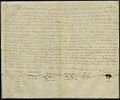Selkirk Concession facts for kids
The Selkirk Concession was a large piece of land given by the Hudson's Bay Company (HBC) to Thomas Douglas, 5th Earl of Selkirk, in 1812. The Hudson's Bay Company had a special right to control all trade in a huge area called Rupert's Land. This land included all the rivers and lakes that flowed into Hudson Bay.
The Selkirk Concession, also known as Selkirk's Grant, was a big part of southwestern Rupert's Land. It covered parts of what are now southern Manitoba, northern Minnesota, and eastern North Dakota. It also included small pieces of eastern Saskatchewan, northwestern Ontario, and northeastern South Dakota.
Lord Selkirk wanted to create a farming community here. He called this area the District of Assiniboia. He brought poor people from Scotland and Ireland to live there. Lord Selkirk hoped this new life in Western Canada would help them escape poverty. In return, he promised the Hudson's Bay Company 200 workers each year. He also agreed to let the company build trading posts and give land to their retired employees. The first settlers arrived in 1812 with Miles MacDonell.
Contents
What Was the Selkirk Concession?
The Selkirk Concession was a special land grant. It was given by the Hudson's Bay Company to Lord Selkirk. This grant allowed him to start a farming colony. The land was located in the heart of North America.
Why Did Lord Selkirk Want This Land?
Lord Selkirk was very worried about the poor people in Scotland and Ireland. He believed that moving them to Western Canada would give them a better life. He wanted to create a new home where they could farm and build a community. This new settlement was called the Red River Colony.
Where Was the Selkirk Concession Located?
The Selkirk Concession was a very large area. It stretched across parts of modern-day Manitoba, Saskatchewan, Minnesota, North Dakota, Ontario, and South Dakota. Its borders were set by rivers, lakes, and specific lines of latitude. This made it a key location in the fur trade routes.
Challenges and Conflicts in the Colony
Even though the Hudson's Bay Company had trading rights, many Indigenous groups already lived in the area. They did not agree with the company's claim to the land. Also, the Hudson's Bay Company faced strong competition. Another fur trading company, the North West Company (NWC), often ignored the Hudson's Bay Company's rules. They also argued over who owned the land.
The Red River Colony Faces Trouble
In 1814, the Hudson's Bay Company used its special royal permission to order the North West Company to leave. Selkirk's settlement, the Red River Colony, became caught in these arguments. The colony faced problems from North West Company fur traders. It also faced issues from American business interests. Some local Métis people also resisted the colony.
The Battle of Seven Oaks
Tensions grew higher and higher. In November 1815, a new governor, Robert Semple, arrived with more settlers. This led to a major fight known as the Battle of Seven Oaks in June 1816. In this battle, a group of North West Company employees and Métis, led by Cuthbert Grant, fought against the Red River settlers and Hudson's Bay Company workers. Governor Semple and 20 others from the Hudson's Bay Company side were killed. One person from the North West Company side also died. This event was part of a larger conflict called the Pemmican War.
The Colony's Growth and Changes
By the 1830s, the colony was growing. Farmers were producing over 50,000 pounds of flour. More than 1,000 settlers lived there. The promise of free land meant many new people kept arriving.
The Colony Joins Canada
By the 1850s, the Hudson's Bay Company started to lose interest in giving money to the colony. In 1867, the United Kingdom created the Dominion of Canada. This new country was formed from British lands in eastern North America. In 1869, the Hudson's Bay Company gave up its trading rights in Rupert's Land to the British Crown. The Crown then transferred this land to the growing country of Canada.
However, the existing settlers, Métis, and Indigenous groups in Red River felt ignored. Their concerns were not being addressed. Because of this, the Métis leader Louis Riel set up a local government. This government wanted to make sure the local people's rights were protected when the land was handed over to Canada. This led to the Red River Rebellion in 1869-70. As a result, Canada agreed to create the province of Manitoba in 1870. This new province was formed on land that had been part of the Selkirk Concession.
Images for kids



